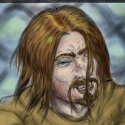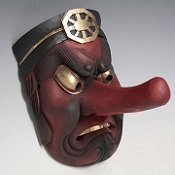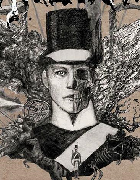|
As I understand it, pretty much all UK LARP groups (not counting Minds Eye Theatre, since that's a non-contact LARP) have pulling your blows, no stabs and no headshots as the rule - when everyone is bringing this particular type of weapon, they pretty much have to. As to weapon breakage, that depends on manufacturer. The one I showed the picture of is a Medlock weapon. They're made by one guy in his apartment who only works with one retailer, and they're some of the most well made LARP weapons you'll ever come across (he considers himself very much a craftsman). I don't own one, but a friend of mine does, and they're characterised by being pretty heavy as LARP blades go, yet very well balanced and durable. The friend in question has a Medlock blade that he's been using in a monthly game and in festivals for years, and it's never needed any kind of repair (including repainting) - and he tends to play warrior types. Light Armourers, on the other hand, used to sometimes have problems with the latex peeling off of the weapon after a few hours of serious fighting.
|
|
|
|

|
| # ? Apr 18, 2024 10:44 |
|
ThisIsNoZaku posted:Wu Xing: The Ninja Crusade pt 2 Some of that update was already posted in your part 1 I'm really enjoying this Wu Xing writeup; I bought the game in a recent DrivethruRPG sale and haven't had the chance to read it yet. The idea of "hidden villages of ninja clans" sounds familiar because, well... that's what it is, a really old concept. You can trace its modern form back to this novel and the general tendency of modern day ninjutsu schools to claim descent from historical clans and regions of Japan (sometimes with certificates and all).
|
|
|
|
Cyphoderus posted:Some of that update was already posted in your part 1 Thanks for the heads up, fixed. Cyphoderus posted:I'm really enjoying this Wu Xing writeup; I bought the game in a recent DrivethruRPG sale and haven't had the chance to read it yet. I should have made the fact that I was joking more obvious.
|
|
|
|
Hardware Repaired... Reconnecting to Gridspace... "Hello, Mr. TheD, Welcome Back To FATAL & Friends!" Alternity: The other Half of the Equation (Chargen Part 2) 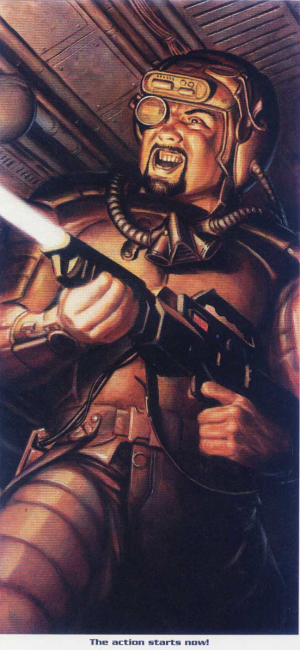 Yeah, this is where it deserves to be... but sadly not... So, now that we know what races we can pick from, let's go take a look at the stats and classes, shall we? As mentioned, there are six stats, and the human baseline for them is between 4 and 14. They're largely self explanatory, being renamed versions of the six D&D stats. And you get 60 points to split between them, making the average for a hero 10 (average human is 9). However, like AD&D, classes have stat requirements to them. So let's go into the classes, then derived stats, and then the end of the update. The classes are nearly all self explanatory, but each has a special ability. In the order they appear, they are: 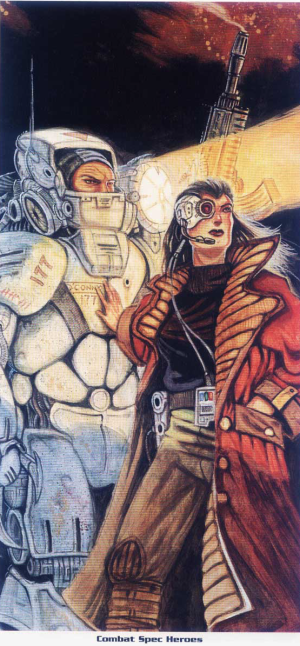 Yes, this game has power armour... and it's not bad... Combat Specs – They hit things, shoot things, and kill things. They're not complicated. They get a +3 bonus to their base Action Check skill (yes, initiative is handled like skills in this game... but you can't improve it except with cybernetics, psychic powers, or other arcane means), and they can pick one weapon or armour skill which they get a -d4 bonus to rolling. As we'll see, though, they're even more limited once you get to skills than usual for warriors, and that can get awkward. They need minimum 11 Strength, and minimum 9 Constitution. Diplomats – These are the talky guys, but they also double as the “spy” class for the game. In the James Bond sense, not the “rogue” sense. Interestingly, it is this class that has the greatest skill freedom, not the Free Agent class, because of what I consider their primary special ability: They get to pick a second class, and get cheaper skills for both the Diplomat class, and whatever other class they picked. They also get a +1 to their Action Check skill, and start with either Contacts or Resources as a talent. Considering the focus in Alternity is very much on skills, these guys are the secret power-houses of the game. They need minimum 9 Willpower, and minimum 11 Personality. Free Agents – Free Agents are basically rogues. there's not much else to say about them, except that they're luckier than any other class (1 extra Last Resort Point, which is basically Luck, and they can spend 2 on any roll as opposed to everyone else's 1), can pick a stat they're better able to oppose people with (adds a dice step to the penalty of anyone trying to beat that stat), and get +2 to their Action Check skill. They're kinda middle of the road. They require 11 Dex and 9 Will. 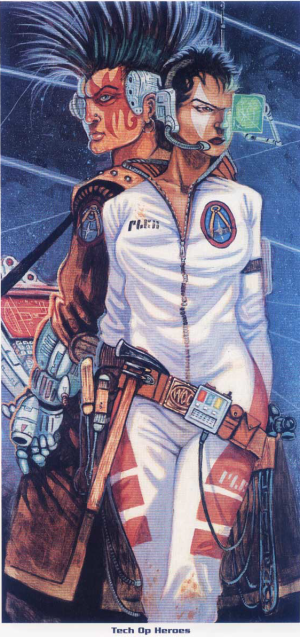 Cyberpunkin': Tattoos Not Optional. Tech Ops – Short for Technical Operatives, these are, obviously, your techy guys. Their special ability? To learn quicker than other people (More skill points per level). Their skill focus, obviously, is on techy stuff, and they get a +1 to their Action Check. Gots to have 9 Dex, 11 Int. and finally, there's Mindwalkers... except, because Psionics is an optional rule, they're not described as a class until Chapter 14 of the PHB, and only their stat requirements of Con 9, Int 9, and Will 11 are shown in the classes section at the beginning. Skipping forward, we find... they have a +1 to their Action Check, and can pick one psychic Broad Skill to have a -1 step bonus on... which is potentially a much sweeter deal than the Combat Spec's skill specialisation. But we will get to why when we get there... So, we've got the stats, we've got the races, we've got the classes. What's next? Well, if you're using optional rules, gotta work those out (the base set are Mutations, Psionics, and Cybernetics, all three of which are default in Star*Drive), and then you have to sort your skills out. We'll mainly be dealing with skills when they come around in the book (after basic rules), but for now... we'll note that it makes the “mistake” of relating skills to intelligence. Specifically, you can buy INT/2 Broad Skills, and (INT-1) x 5 Skill Points worth of stuff overall. Now, I will say that I actually like intelligence based skill systems, but it does often lead to min-maxing, and I can perfectly understand why many people dislike them. We'll leave it at that, and move on to the next steps, and the next complaint people have against Alternity. See, when it says Player's Handbook, it's really not joking. Much like AD&D, and a lot of systems before and since, the Player's Handbook is entirely filled with precisely two things: How to make a character (90% of the book), and the resolution system (10% of the book). As such, this means there's a lot of page flipping if you want to make a character, and, much like GURPS (which has a very similar pair of corebooks), it's point buy, which means making players takes time, and that puts a lot of people off. Again, I can perfectly understand this, but I happen to like it myself, due to the fact that, unlike many other systems, it really doesn't gently caress around. So what's left? 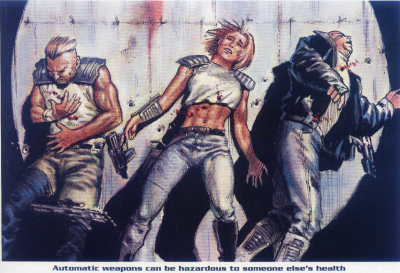 This is evidence that the book is not amazingly well organised, being in the chargen chapter. Also... No poo poo, Sherlock! Perks and Flaws (Chapter 5), Motivation, Moral Attitude, and Character Traits (Chapter 6, or do what most experienced players do, and just skip them by writing a decent backstory that tells us these things), sort derived stats (in the chargen chapter), and sort out your starting cash and kit (Chapters 9-11). So, let's look at the derived stats. Last Resort points are basically Luck Points. They modify rolls, and we'll deal with them in a couple of updates time, along with the rest of the system. Action Checks, however, allow me to give a little preview of it... Skills have three levels of success: Ordinary, Good, and Amazing. Action Checks, because they're basically initiative, also have a Marginal level of success. How is this calculated? Well, in the case of skills, Ordinary is the associated stat + skill level, Good is half that, and Amazing is half that (rounded down). In the case of Action Checks, the stat is the average of your Dexterity and Intelligence (rounded down... always rounded down), and Marginal is anything highis than that. Obviously, you want to lowball to win. All actions in a phase happen simultaneously. The next derived stat is Actions Per Round. That's right, you can act more than once, if you're good enough! This is derived by (CON + WILL)/8... all togethis now... rounding down. Finally, the highis your Strength and Dexterity are, the quicker you can move in combat, which makes perfect sense. Finally, we come to Durability. Which is, to me, an interesting set of stats. Essentially, you have four types of hit points: Stun (which K.Os you if it goes to 0), Wound (which seriously fucks you over if it goes to 0), Fatigue (guess), and Mortal (0 = You're dead). Wound and Stun are both equal to your Constitution, while Fatigue and Mortal are half that, rounded... up. Yes, that's right, I lied. Some things round up. But not often. Finally, if you're strong, you do slightly more damage with melee and unarmed, and if you're not, you don't. there, that was relatively painless, wasn't it? So let's talk about the rules next time, and start making those characters the update after, a'ight? See ya then!
|
|
|
|
 Part 3: More Region A Remember how the dungeon starts off with a fiendish darkmantle, fiendish rat swarm, and fiendish stirges? Well, get used to it, because these are the bulk of the monsters in this section. Sometimes the rats are dire rats rather than swarms, and sometimes the darkmantles have more HD but you will get absolutely sick of seeing more of these three. They also significantly outnumber the humaniods in the region, each of which are clustered in small groups in the dungeon. Darkmantles especially make up the bulk of encounters That's the most common complaint about Region A, the complete lack of creativity when it comes to monsters. And it's not like there aren't plenty of choices for low CR animals and monsters that could be used: wolves, dogs, spiders, centipedes, hyenas, boar, snakes, etc. It gets so bad there's a series of rooms which are nothing but darkmantles of increasing size and HD. Starting with A88 you've got five fiendish darkmantles, Then you've got 7 more in room A89. Then you've got five more darkmantles, but these have 2 HD!. Then you've got 6 more in A91, but with 3 HD. Then, just to mix things up...boom! 4 regular darkmantles! And remember what I said about being brutal? These are EL 6-8 encounters for a party that is (at best) level 3. Encounters that involve blankets of magical darkness and flying creatures with blindsight. So...lets see if we can find some other notably bad areas...How about the troglodyte lair:   Keep in mind that troglodytes are pretty tough for low-level monsters: they've got 13 hp on average, multiple attacks, and decent AC. Now, add on a permanent -2 penalty to pretty much all rolls while you're in their territory. One of the PCs first encounters in this area is an ambush featuring 6 of these guys. The cartography here is also exceptionally bad. There are two a33's in the adventure, one referring to the actual room a33 on the map, the other apparently referring to the 4-way intersection marked A, B, B. And rooms A31, 32, 35 and 36 where the stench is exceptionally intense? Well, except for the first one, each of those rooms are behind secret doors that the troglodytes have never found or entered. Oh, and A31 starts out with 8 Fiendish Stirges. Because everyone loves more ability damage! A34 is listed as EL 2, despite the fact that it includes a CR 3 opponent (incorrectly listed as CR 4) backed up by 4 wounded troglodytes. A52 is also a real gem:  Now, if you touch the throne at all you must make a DC 14 will save or suffer a Confusion effect that lasts for 30 days - your Wisdom score. This takes effect any time you're under stress which is defined as whenever you're in combat or you must make a skill check. that's right, for over two weeks for most players you will now go insane whenever you attempt to do pretty much anything. This makes most any skill checks impossible and combat insanely difficult. It also has it's own, unique confusion table. You remember how with normal confusion there was a chance to act normal? not here. You'll either attack an ally, become nauesated, cower in fear, flee at top speed, or twitch uncontrollable (-2 to attacks/saves/skills/ability rolls). And again, for most people this is a 2-3 week affliction. Of course, DC 14 isn't too high (unless you happen to be a 1st level fighter, rogue, ranger, or barbarian), what if you succeed? well, that means you sense "something strange" has happened. That's right, touch the throne and you're hit with an unavoidable curse which you probably will not be aware of. And of course if the entire party touches it then next time someone attempts to look for traps they'll go nuts, which will probably the the cue for everyone else's curse to trigger leading to them murdering one another or fleeing wildly into the depths of the dungeon. Oh, and since it's not technically a trap or even magical it's basically undetectable. --Traps-- Region A loves deadly traps guarding absolutely nothing at all (or just more traps). For instance, A79 features a scorching ray trap (find/disable DC of 27 and an average of 14 damage) which guards several barrels covered in black mold. The only contents of the barrels are some vinegar. Yay, vinegar! A83 features a 6th level fireball trap! It's a potential TPK right there and it guards....a completely empty room. At least there are some burned bodies here to warn you that the area is dangerous. This is not the case for the door at A87 which is trapped with not only a scything blade but also a lightning bolt trap (also 6d6 damage). This one guards a room full of mundane weapons and armor, a couple of doses of poison and the possibility of a couple of masterwork objects. Later (A94) we have an empty chest guarded with a scorching ray trap. The authors make sure to point out the room is trapped, not the chest and anyone approaching to search the chest for traps will be targeted. Not that it matters since DC 27 is pretty far out of reach for low level rogues who aren't allowed to take 20. A105 features another fireball trap (this one with no warning), but at least it contains some scrolls, potions and magic items. In fact, this small cache of treasure is the biggest in the entire region. The dungeon is extremely stingy when it comes to magic (or even masterwork) items, something that will really hurt the PCs in many encounters. Room 106 is especially bizarre...it has a celestial rune that if a lawful or good PC stands on it they're healed 2d8+3 damage and cleansed of poisons or ability score damage. Chaotic or evil characters suffer 2d8+3 damage. Meaning chaotic good or lawful evil characters are apparently healed and damaged in equal amounts. There are similar rooms in the area as well. Next time I'll check on some of the awful NPCs in Region A.
|
|
|
|
So it's badly structured, harder then it should be for the expected character levels, and the gently caress yous aren't even interesting.
|
|
|
|
Robindaybird posted:So it's badly structured, harder then it should be for the expected character levels, and the gently caress yous aren't even interesting. That's not true! Who doesn't like fighting darkmantles forever!
|
|
|
|
It's a crime to design an Ultimate Megadungeon To End All Megadungeons and not include a room where the floor is a trapper, the ceiling is a lurker, the walls are stunjellies, and 1d3 cloakers hang on a coat rack that is a mimic.
|
|
|
|
Piell posted:That's not true! Who doesn't like fighting darkmantles forever! Not to mention the... ah, you haven't finished Region A yet... nevermind. Suffice to say, there are bigger gently caress you's... but not necessarily better ones. And I definitely agree with Halloween Jack on the Room of Certain Death. If you're going to be an adversarial dick (like the designers of WLD), then at least do it with style. EDIT: Although I still think you can't top "You bust through the door, and the room is a Gargantuan Gelatinous Cube. Good loving luck on your strength checks, gently caress you, goodnight!" JamieTheD fucked around with this message at 21:15 on Apr 23, 2013 |
|
|
|
What's particularly weird are the ELs. Even though ELs are dicey in the first place, it's just sheer not-giving-a-gently caress to throw low-level PCs against that many high-level encounters. The first level of a dungeon this big, by definition, doesn't need to be overtly challenging, but instead should a primer to concepts and themes in lower levels. If you have a lot of room to work with, use that to your advantage, not to your detriment.
|
|
|
|
Halloween Jack posted:It's a crime to design an Ultimate Megadungeon To End All Megadungeons and not include a room where the floor is a trapper, the ceiling is a lurker, the walls are stunjellies, and 1d3 cloakers hang on a coat rack that is a mimic. This is in there, just in area F(UCKYOUADVENTURERS). Also every hallway leading to or from the room is packed with gelatinous cubes.
|
|
|
|
Majuju posted:This is in there, just in area F(UCKYOUADVENTURERS). Also every hallway leading to or from the room is packed with gelatinous cubes. I mentioned before that I'm trying to basically re-write the WLD into something vaguely worthwhile. Well, Region F deserves special mention as it's the first area so far I deem completely beyond saving. Details will have to wait, but lets say it involves random teleportation and status effects as a common feature of exploring the area.
|
|
|
|
Do you guys want me to cover Monster and Other Childish Thing's sample characters, or skip them? I'm afraid it might make boring reading.
|
|
|
|
I honestly think the WLD missed a huge idea in monster villages just catering to adventurers. They salvage the dead, sell their poo poo to the next group, maybe do some local diplomacy with the next floor down to try and keep the room full of strikes from expanding. Like the idea of a gigantic dungeon as a living ecosystem and small world of its own could be great. But, well...
|
|
|
|
Robindaybird posted:So it's badly structured, harder then it should be for the expected character levels, and the gently caress yous aren't even interesting. The big twist: the dungeon is actually inside the guts of a massive Darkmantle.
|
|
|
|
Speaking of World's Largest Dungeon, Piell had tried running it awhile back. But the group did not get very far. At the time I was disappointed that I didn't get into the game, and now I myself have a recruitment up in The Game for it. The Dungeon really does seem to be actively designed to screw with people, but with frequent replacements of dead characters it might be fun, in a way.
|
|
|
|
 ASHEN STARS Website pdf on DriveThru RPG Part 1: Lasers, The Bleed, and you Ashen Stars is a space opera game by Robin D. Laws (Hillfolk/DramaSystem, Feng Shui, Robin's Laws of Good Gamemastering, The Dying Earth, Over the Edge, Ken and Robin Talk About Stuff), published by Pelgrane Press, which uses the GUMSHOE engine for investigative games. You may recognize GUMSHOE from the horror investigative games The Esoterrorists, Fear Itself, Trail of Cthulhu, and Night's Black Agents, or the superpowered CSI game Mutant City Blues. Ashen Stars takes the system away from the 'present day meets the unreal' format to the stars, which may or may not happen to be ashen. It draws huge inspiration from Firefly, the grittier bits of Star Trek, the jedi-free parts of the Star Wars universe, and anything else involving people meeting aliens and solving mysteries in order to keep on trucking. I'll be doing these writeups alongside the book's layout, generally one chapter at a time. The way information unfolds reminds me of Mouse Guard, in that it starts with the highlights about the game's mood, central activity, world, and where the player characters fit in it. If you have more concrete questions about just how it works, trust me, we'll get there before long. It's a game of utopianism vs bitter reality, altruism vs selfishness, and ray guns vs your face. Let's dive in: Chapter 1: All the Justice Credits Can Buy  This ship goes in space. It is a spaceship. The book proper starts with an in-universe description if the major bulletpoints of the setting and how you fit in it. You are a Laser, a freelance contractor paid to represent the law. You operate in the Bleed, a semi-autonomous frontier region of space where the Combine governemnt is weak enough to need freelance contractors to represent the law. Laser crews are known to succumb to the cash that often accompanies corruption, but bad reputations also lead to bad contracts. It's up to you to walk that line. Not long ago things weren't so strained. The Combine is an amalgam of space empires that had dedicated itself to peaceful exploration and discovery and the Bleed was its brave new frontier. Then, a disastrous war came with the Mohilar. Nobody remembers the Mohilar clearly, and reports are often contradictory. This ill-understood psychic phenomenon is called the Bogey Conundrum. All that's for sure is they were bad news. The war crippled the Combine fleet, poisoned planets, and scarcity returned to the galactic economy with a vengeance. Now, as the Combine licks its wounds and the Bleed tries to cope, the duties of law and order have fallen to you. Lucky, lucky you. Creating Your Character:  You can make this guy, or someone with fashion sense. In order to play as a Laser, you'll need to make up a Laser. First, pick a species: Balla: Space elves but also Vulcans Cybes: They're cyber men, possibly also Cybermen Durugh: Fought against the Combine not too long ago, have the ability to phase through solid objects Humans: Completely unrelateable to me The Kch-thk: Warrior locust people that reincarnate. These guys are fun. Tavak: A noble warrior race with a strict ethical system, but surprisingly smooth foreheads The Vas Mal: There was once a mighty race of near-omniscient energy beings. There is now a race of runty blue people. What's up with that? Second, assign crew packages. Think of a package like a class. Each one comes with certain skills you'll need in your life as a Laser and determines your role. You get one for on the ship (Warpside) and one for off it (Groundside). Warpside packages are communications, pilot, strategic co-ordinator, systems, and weapons. Groundside packages are cultural, operations, survey, security, and technical. The Medical package has uses in both settings, so it's a special case where you only need the one. At some point you should think about what your Laser did during the Mohilar war. The book places this before choosing a species, but I think it fits here just as well. There's no mechanical consideration here, but there are suggestions from the typical (serving/avoiding the war effort), rarer (just woke up from a coma and missed the whole thing), and the setting unique (was a swirling energy being untethered from limited notions of space, time and causation). Next is choosing your investigative abilities. This is a game about solving mysteries so these are really important. This is also the first time we touch on GUMSHOE rules directly. Every section in this chapter directs you to a later chapter that deals with these things in-depth so I'll repeat myself: trust me, we'l get there before long. Character creation is meant to be done as a group, and this part is dependent on your group size. Everyone has a certain pool of points to spend, and the size of that pool depends on the size of the group. Smaller Laser crews are made of generalists and larger ones are made of specialists.  Looks like nobody bought the 'Erect Police Line' ability Start by subtracting the cost of your crew packages from your total, that leaves the number you have to spend in this step. The GM reads down the list of investigative skills and whoever wants each one says so, and spends a point to get it. Every skill needs at least one person to have it. It's sort of like starting Risk by going around the table and everyone putting an army on a territory. Once all the skills are taken you have three options for your remaining points: hoard them and assign them during play when they become relevant, buy into an ability someone else on the crew has, or add more points to an ability to increase your proficiency in it. You can also do all of the above in some combination. They're your points, go nuts! Species' and crew packages also come with benefits to certain abilities, so you should probably get those for sure. We'll cover the full list of abilities and why they're cool later, but here's some highlights from the list: Forensic Accounting, Cybe Culture, Linguistics, Bullshit Detector, Cop Talk, Respect, Explosive Devises, Holo Surveilance, and special Vas Mal abilities like Timesight. Next is general abilities, which work a lot like Investigative abilities but different. They cover things like your health, ability to shoot, punch, and fly, capability with technical systems, and the other activities that keep you alive and in business. Everyone gets 75 points to spend and I reccomend putting all you can afford in my favorite ability in any game: Public Relations. Another difference between the two types of ability is what their value says. One point in Botany means you are a good enough botanist to find any core botanical clue. One point in Shooting means you often know where the trigger is on most guns. A four or five is generally competent, while an eight is more like The Spaceman With No Name. There's no cap on abilities, but your second-highest rating must be at least half the value of your highest.  Rating of 7 in hair, 0 in smile The next step is one of my favorite things about this game (my other favorite things are later in the chapter): choosing your drive. A Laser's drive is their motivation for being out in the bleed. The list is varied, inspires ideas, and keeps characters within space opera tropes while leaving plenty of breathing room. The drives chapter will be a fun one where we'll talk about Combinism vs Bleedism, Altruism vs Entrepreneurial drives, and how Sexual Adventure really can work in this game. The next two steps are about your gear. First, choosing the rustbucket you'll call home; and then the enhancements you'll give it and yourselves. There's a whole array of trans-human enhancements, special-purpose gear, and modular ship parts to pick over, and Laser crews do get a budget to start out with. Cash is very important in Ashen Stars. You get it by carefully walking the line between hired thugs and noble lawmen, and without it your robot parts won't work and your ship won't fly. This is tied to the Reputation system. New Laser crews start with Reputation 0, the neutral value. Now that you know what characters are made of, it's time to add the personal touch. Names, physical descriptions, and stuff like that are cool and necessary, but Ashen Stars asks for something better: Personal Arcs. Your personal arc is the thing your subplots are built around. They're what your 'B-plots' are made from, and when the 'A-plot' touches on them it's a chance for your Laser to shine and invest the emotional impact that can make a session really special. This section reveals how indebted the book is to TV procedurals in its language, and this example that couldn't possibly be a joke at a certain show's expense, nope: quote:In an episode of an imaginary TV series, the crew of the spaceship Brasilia intercede in a civil war between two seemingly indistinguishable factions of an alien species. Meanwhile, Commander B.O.R.N., in his ongoing attempt to learn what it is to be human, tries to master the subtleties of the trombone. Arcs are essentially goals with a vague plan to get there. Here's the format for making one up, and if you never play Ashen Stars I recomend stealing it for use in the game of your choice: 1. A brief sentence or phrase expressing your character’s most important goal. 2. (Optional) A second sentence showing how this goal relates to the character’s internal conflict between altruism and selfishness. 3. A brief sentence or phrase suggesting an introductory subplot featuring your character. 4. Another subplot that builds on the idea introduced in the previous one. 5. A third subplot concept, again building on the others. You can see how just a little bit of homework can turn any series of games into a well-developed, character-facing campaign. I love Personal Arcs. I love them so hard. Suggested themes to inspire personal arcs are the game's interest in altruism vs selfishness, conflicts between impulses and aspirations unique to each species of the Combine, or even lifting the description of your Drive. Doing one of those would leave you with a thematic goal; open-ended and reusable. Arcs can also be based on concrete goals that have a clear, achievable end; like solving a greater mystery or earning a particular accolade. Both work, and having a crew with some of each sounds like fun to me. The rest of the chapter is fun stuff about how to implement personal arcs and subplots in a satisfying way. I'll happily answer questions about it, but it's just sound GM advice and nothing specific to the game so I don't feel a need to summarize it just yet. Next time: The species of the Combine  Personal Arc: Learn how to high five General Ironicus fucked around with this message at 22:47 on Apr 23, 2013 |
|
|
|
ADVANCED DUNGEONS & DRAGONS: 2ND EDITION - The Complete Psionics Handbook Chapter 3 - CLAIRSENTIENT SCIENCES OR OF COURSE A LEVEL 1 PSIONICIST CAN REMOTE VIEW ACTIVITIES ON OTHER PLANETS 5% OF THE TIME, WHY COULDN'T THEY? Chapter 3 sets the standard for the next six chapters by listing in alphabetical order the powers associated with each of the schools of Psionics. As previously mentioned, the schools are broken into Sciences and Devotions, where Sciences are supposed to be your bigger, more powerful abilities that get poo poo done, and Devotions are more like your minor cantrips that might be situationally useful but aren't a great power in every circumstance. Each power is presented thusly: Power Source - STAT or STAT-X, which represents the target roll-under number on a d20 that a Psionicist is aiming for while attempting to manifest a psionic power. You can't successfully manifest any kind of power without first succeeding at a power check. If you fail your check you don't manifest the power but you still have to spend half of the total number of PSPs that would have been required for a successful manifestation; ostensibly this is to prevent Psionicists attempting to manifest something infinitely until they are successful (because we don't want them to approach parity with clerics or mages remember). Initial Cost - As above, the cost paid after a successful manifestation. Half the cost is paid even if you fail. Maintenance Cost - The cost in PSPs to maintain a power for an extended duration. The maintenance cost is paid relative to the length of time that a power originally lasts for, so a power that lasts for one round normally has to pay a maintenance cost every subsequent round whereas powers that have a longer base duration (say a whole turn) pay maintenance costs less frequently. Range - How well each power can convey a believable performance given a variety of different dramatic material. Prep Time - Tells you for how long a Psionicist has to spend powering up DBZ style, complete with multi-hued auras and needless grunting, before actually being allowed to attempt to manifest a power. Fail to manifest a power that had a three round warmup? Hope you got three more rounds to power up all over again! Area of Effect - No surprises here. Prerequisites - A ham fisted method of trying to gate off low level psionicists from immediately choosing the most awesome of psionic powers. Functionally this barely limits what a starting psionicist has access to, so Steve took the extra step of making most powers completely pathetic in order to prevent psionicists from overshadowing mages and clerics in terms of utility. POWER SCORE / 20 / 1 - Every power does something special if you roll exactly the power score on your power check, or a natural 20, or a natural 1. Further hoses psionicists by making sure that the vast majority of powers have a flat 5% chance to royally backfire. On the other hand, 5% of the time you might also get a slightly more enhanced effect than what you expected! Also, sometimes rolling a natural 1 on the power check also makes something bad happen, so it's closer to 10% of the time that a psionicist, regardless of level or skill, is going to get his poo poo pushed in just for daring to use his class ability. I'm not even sure why rolling a natural 1 should punish you because I'm fairly certain that a natural 1 is the lowest you can roll in a roll under system. Alright, now that we're on the same page here, I'm going to go through all of the Sciences and Devotions for each of the schools. I'm not going to bother transcribing every variable for every power unless some of them are especially useless / hilarious, in order to keep these lists from boring you to tears. CLAIRSENTIENT SCIENCES: As a fun aside, none of the Clairsentient Sciences or Devotions have any prerequisites. It's like Steve knew these were so lovely he didn't even bother to gate them off. Aura Sight - Requires WIS-5 to activate and costs 9 PSPs, so a starting Psionicist with the minimum required attributes is going to fail at this half of the time. Using this power lets a Psionicist learn either a target's alignment or experience level, but not both at once. You have to manifest this power twice and pay 18 total PSPs (assuming you don't fail either time with a success rate hinging on a coin flip) to learn BOTH a target's alignment and experience level, because the rules specifically state that even though you can use this power on two targets per manifestation, you ABSOLUTELY CAN'T target the same person twice to get all of the necessary info. Also, you can't be subtle when you manifest this power because you have to scrunch your face up really hard and furiously glare at your target(s), so even non-psionicists can definitely tell you're doing something bizarre. This is all literally written in the power's description. POWER SCORE / 20 / 1: You can read four auras per round instead of two (still no doubling up on information) / The power fails and you can't use it again on anyone for 24 hours / You read the aura but the DM is supposed to lie to you about one of the dimensions (either you get the wrong alignment or you are told the wrong experience level). Clairaudience - Project your mind to a distant location and hear everything happening as if you were actually present at that location. Activates on WIS-3 so a stating psionicist will fail 40% of the time. The big draw here is that both this power and the next (Clairvoyance) list an additional difficulty table you incorporate into the power check based on how far away the location you're trying to listen to is relative to you. The amazing thing about this chart is that the maximum distance is INTERPLANETARY, and while attempting to listen to something at that distance adds a hefty penalty, both this power and the next don't have a specific penalty listed for rolling a natural 1, which means that 5% of the time a level 1 psionicist with the minimum required attributes can hear or see things happening on other loving planets. Steve kind of wised up here because he quickly points out that if you're familiar with the SPELLJAMMER rules, Clairaudience and Clairvoyance can only be used within the same sphere/plane of existence. No Jeremy, your Psionicist on ATHAS can't start some kind of inter-dimensional cooperative effort with Psionicists on Aber-Toril to take over the multiverse. POWER SCORE / 20: You also gain Clairvoyance at the same location and for the same duration / you go deaf (no save) for d12 hours. Clairvoyance - As above, but seeing not hearing. Still allowed to peek into the bedroom of some hideous being from the far realm, as long as you aren't trying to peak into an unspeakable horror's bedroom on GreyHawk. POWER SCORE / 20: You also gain Clairaudience at the same location and for the same duration / you go blind (no save) for d12 hours. Object Reading - You can learn all about whoever last touched a given thing - their race / sex / age / alignment / how they gained or lost the item in question. The better your power check, the more info you find out at once. You can only scan a given item once per experience level, because it'd be way too OP to allow a guy to learn both the race AND sex AND age of the last person to touch a sword. This power also takes one round to fire up, because it would be literally game breaking if you could read an object's aura at the same speed with which you can read a living thing's aura. POWER SCORE / 20: You automatically learn all of the possible information / You become obsessed with the item in question and strive to keep in on you at all times until you gain a level and can rescan the object. Precognition: Activates on WIS-5 and costs 24 PSPs to fire off, also requires you to POWER UP for five rounds prior. You describe a specific course of action to the DM and then depending on how well you roll, he may or may not give you some indication of how that specific course of action might turn out. Of course the DM isn't under any obligation to make sure that what he just told you correlates with what actually happens, and if you don't describe a precise enough sequence of events, the DM is given permission to completely bullshit you. Also, once you use this power, you are so tired that you can't use any other Clarisentient powers for ten whole rounds. Everyone loving loves the "mother may I?" approach to game play! POWER SCORE / 20: You can roll some dice and argue with the DM if he doesn't rule the future in your favor (good loving luck with this) / You see yourself suffer a violent, grisly death and have to save vs. petrification or else all of your power checks suffer a -3 penalty for d6 hours. Sensitivity to Psychic Impressions: You can tell if events occurred in the past that left strong psychic impressions in the 20 yard radius from which the power originates. What effect this has, if any, on actual game play is left completely up to your imagination. The book makes sure to tell you that you might learn about someone getting married, or having an argument, or having a baby in the area though. The psionicist's understanding of these events is supposed to be murky at best, making me seriously question why this power was even included. You spend a non-trivial number of PSPs to activate a power you'll fail at manifesting 45% of the time to learn vague things about a place. POWER SCORE / 20: You get a better understanding of what happened and why (still no mechanics to explain what this means) / An angry ghost materializes and immediately casts the mage spell magic jar against the Psionicist. This doesn't make a ton of sense because the ghost isn't stated to be holding a vessel capable of functioning as a magic jar, and monsters in the MM don't generally have a listed WIS score so it's hard to calculate what the Psionicist's penalty to their save imposed by magic jar would be. Based on my interpretation of how the magic jar spell functions, I think Steve was trying to explain that an angry ghost materializes and immediately attempts to take over the Psionicist, but he couldn't really come up with an eloquent way of indicating that and just kind of went with the path of least resistance. I'm aware that 2E Ghosts had the magic jar spell listed as a combat ability in the MM, but it isn't super well explained there either. NEXT TIME: CHAPTER 3 - Clairsentient Devotions OR I WANT TO HEAR LIGHT AND SMELL SOUND AND YOU CAN'T STOP ME Freaking Crumbum fucked around with this message at 22:57 on Apr 23, 2013 |
|
|
|
Just to add insult to injury on the Power Score/20/1 system, a bit of errata in one of the Dark Sun books states that if your PS is 20 or above you no longer have a chance at even that minor benefit. Things will still go awry on a 20 or 1 though!
|
|
|
|
Bieeardo posted:Just to add insult to injury on the Power Score/20/1 system, a bit of errata in one of the Dark Sun books states that if your PS is 20 or above you no longer have a chance at even that minor benefit. Things will still go awry on a 20 or 1 though! Man gently caress that, I'd rule that if you can finagle your Power Score to be greater than 20 for a given power, you ALWAYS get the PS effect. It'd put psionicists a little closer to parity with mages and clerics, and IIRC it was a lot harder to drive up your ability scores in 2E than in 3.X or 4 where your abilities start to increase every four levels. You would have to get your WIS or CON or INT to 30 to be able to confidently qualify for a power score greater than 20 for most of the listed powers, and if you can pull that off in 2E then more power to you.
|
|
|
|
With regards to larps and boffer weapons we have this in Finland: https://www.youtube.com/watch?v=XFYPhmbXvpM It's a large event that includes a series of battles, with somewhere between 400-500 participants every year. The event has a forum in here: http://forum.sotahuuto.fi/ It includes an international section and any international participants would be welcome indeed. The rules allow strikes to the head (helmets are semi-mandatory, but any protective helmet, like an ice-hockey helmet is allowed), thrusting with spears and other weapons with properly made thrusting heads and also bows and arrows. It's not really larping as such, since you don't have specific characters, but the scenarios tend to have a theme, like storming a fortification, protecting a king or contesting a strategic location. The event is run once a year, usually in July, but this year it will be in early August. There are scenarios in Saturday and Sunday, lasting most of the day with a lunch break in the middle.
|
|
|
|
 Janitor's Closet and Being Somebody- GM and Sample Character's Okay, I'm combining these because the GM section is going to be short! This is because it is a very good beginner GM course, and will be nothing new to most people here. Most of the section is standard good-GMing advice. Let your player's direct the story instead of railroading, tailor stories and encounters to the player's so everyone gets to shine, use the character's relationships to create drama, learn how to improv an NPC etc. Notable, is a section about Themes. These are concepts and ideas to explore in a game of MaOTC, to give it more weight and significance to the players. Some example theme's are: Kids Are Powerless, The Back Yard is Full of Adventure, What Other People Think, School is a Microcosm, and Ch-Ch-Ch-Chaaaaanges. They also include two One-Roll generators, one for Conflicts and one for Monsters. While I won't go into detail, these would be good for improving, especially the Monster generator so that you could whip up a quick baddy to beat on if the game is getting dull. Sample Characters The bit most of you want to see, because you get to see more sweet rear end MONSTERS! So let's get started.
Benny is a 12 year old Monster Truck fan. He wears an old beat-up leather jacket that belonged to his brother Peter who died in Iraq. Benny's a pretty smart kid, and decent in a punch-up, but isn't very sociable. His Monster is Mr. Crocker, a giant crocodile. Mr. Crocker say's that he used to be an Egyptian God, but likes Benny's bathtub better than the Nile. He talks in a slow southern drawl, and moves with an odd bouncing gait, like he's full of helium. His favorite thing is swallowing... well, anything whole, but he can spit it up again good as new, if Benny makes him. Lucy Awai and Aumakua A native Hawaiian of very mixed ancestry. Now she lives in a landlocked town, making her a bit of an oddity in the neighborhood. She's a bit of a tomboy, and is great at any sort of water sport. Her association with Aumakua has done strange things to her head, leading her to having prophetic visions, and even getting a crush on a boy she's seen in a dream of the future. Aumakua resembles a Great White Shark, but bigger, badder, and meaner. He's an imperious and mighty presence, but acts like a doting grandparent to Lucy. He can hide within any body of water, no matter how small, and can even swim in the Dream Sea, accessing prophetic visions and dreamscapes.  Tommy Mezlowski and Flytrap Joe Tommy's a quiet kid. He doesn't act out. He keeps it all inside, bottled up for when he needs it. Tommy's got problems. His dad cut out when he was younger, so it's just him, his sister, and his mom. And Flytrap Joe. Joe's a giant, writhing, mass of flytrap mouths and vines, growing from fractal roots in the fabric of reality that allow him to pop up anywhere, anytime Tommy needs him. Flytrap Joe love's to help Tommy, and is sometimes over-eager to do it. He talks like a parody of a 1920's mobster, and calls Tommy “Boss”. Daniel Jackstone and Snaketongue Handsome, cool beyond cool, popular with everyone, best pals with even the losers, the kid with no enemies. Dan's a good kid. Dan's going places. Dan's worried what will happen when people find out about Snaketongue. See, Snaketongue wants Dan to be happy. He wants him to be popular, and powerful, and rich, and loved. So, Snaketongue hides in the reflections in Dan's eyes, using his iridescent scales to charm and bewitch, making people like Daniel. And if somebody finds out that Daniel's messing with their minds? Then they have to deal with a pit-viper the size of a school-bus. Ralph “Dog” Jones and Mister Whispers Dog (Don't call him Ralph), is a street urchin extraordinaire. He's a genuine good samaritan, looking out for his fellow street people, and keeping an eye out for trouble. He's got lots of eyes, cause he's got Mister Whispers. Mister Whispers is a swarm of rats. Big ones. The kind that eat cats, instead of the other way around. Mister Whispers is everywhere. He keeps an eye on things for Dog, keeping tabs on the neighborhood, and scrounging up some cool stuff and a decent meal for his kid. Madison Kate Sinclair-Stevenson and Yog'So-Soft Madison is a textbook over-achiever. She's in all the AP classes, clarinet in the Jazz Band, play's soccer in a competitive private league, volunteers at homeless shelters, runs for student government, organizes Spirit Week, sings in the Church choir, takes karate, and even has private tutoring on the weekends. She also sees three therapists, takes four kinds of psychiatric drug, has a prescription for an antacid, and wishes a monster would come and eater her so very very supportive parents. She'd go completely mad if not for Yog'So-Soft. Yog looks like Cthulhu's Teddy. 6 feet tall, dripping with black and unspeakable ichors. His soft paws end in great raking claws, and his button eyes are split by a torn seam filled with jagged teeth. He's a wise and philosophical old soul, at heart. He's always pushing Madison to think in new ways, particularly about herself and what she really wants out of life. 
|
|
|
|
They're supposed to carry coconuts. Two empty halves of coconuts so they can bang them together. 
|
|
|
|
As penitence for that lovely update, have another monster art. I'm currently trying to put together a Roll20 game with my girlfriend, and I may recruit some dudes from here to play if I'm short on people. I drew her monster for her; Count Webster the Knowledge Vampire.
|
|
|
|
quote:He's always pushing Madison to think in new ways, particularly about herself and what she really wants out of life. "Madison. Dear Madison. You have to think outside the trapezohedron."
|
|
|
|
Can't sleep, so have a big honkin' update! Alternity: Wait, I Roll What? (Rules) 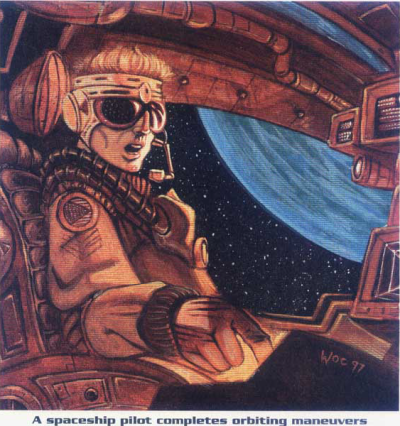 The images, you may have worked out, are sorted by "Rule of Cool", as opposed to relevance. I mentioned before that Alternity has an odd way of doing things. And a surprising amount of people have trouble with it, despite the fact it's relatively simple. So let's start by repeating how skills are calculated. Essentially, you have two types of skills: Broad Skills, which allow you to do anything that doesn't need specialist training in a certain area (like Computer Use, or Unarmed Combat), and what I call Proper Skills, which actually have levels, unlike a Broad Skill, which you pay for once, and never upgrade. So why buy Proper Skills? For two reasons. The first is that, as I just said, you can never upgrade the skill-score of a Broad Skill. It will forever be “Your Stat/Half Your Stat/A Quarter of Your Stat”. Secondly, it gets a +d4 penalty to your die roll, unlike Proper Skills. So, as an example, with a CON of 12, you could have a Stamina Broad Skill of 12/6/3 (+d4), and, picking a sensible number out of the air, a Stamina - Endurance (2) Specialty of 14/7/3. The three numbers are for Ordinary, Good, and Amazing success levels, and you want to lowball. Simple. “But Jamie, what is all this talk of plus and minus various dice?”  The Most Important Diagram In The Book. Well... let's use an example skill. Let's say Ranged Combat – Rifles, at a level of 12/6/3 (a perfectly average skill level). Now, if the person who has this skill is shooting a rifle under standard conditions at medium range, it's a pretty simple roll of 1d20, and they want to roll as low as possible (because Good and Amazing successes lead to better things happening, for obvious reasons). However, the GM might turn around and say “Well, overall, that's a 2 step penalty”. What does that mean? It means that they roll a second die (in this case, a d6), and add it to the roll. Bonuses go from -1 (-d4) to -5 (-d20, aka “Nobody's ever giving you this bonus” or “Oh God, don't bother rolling, you win!”). On the other hand, penalties go from +1 (+d4) to +7 (+2d20, aka “I asked you five times whether you really wanted to do this!”... also rarely given, for obvious reasons.). So, for this average rifle skill, this ranges from nigh 100% chance of success, to 60% for +0 steps, to perhaps less than an 8% chance at the very top end of the penalties. However, there is a flat 1/20 chance apiece for either a critical success or a critical failure, regardless of the total value of the dice. A natural 1 on the d20 always succeeds, while a natural 20 always fails. Of course, if you don't like criticals, you can always leave them out, I find. Assisting characters is basically a roll to see how many steps up or down you shuffle the player doing the thing he's rolling for, doing two things at once is a straight +2 step penalty on the main action, and a +4 step penalty (+d12) on the secondary action, and, obviously, both actions must be physically related (IE – things you can actually do at the same time). Simple, right? So now, let's talk about initiative and damage. We mentioned how Action Checks work before (a failure isn't a failure, it's the fourth phase of Initiative, actions are simultaneous in a phase, and it's just like rolling a skill), but what we didn't mention is postponing actions and more than one action in a round. If you have more than one action a round, you actually have the chance to lose actions in a round, because there are only four phases. Your average character has 1, maybe 2 actions a round... so if a 2 action character got a Good Action Check, they act on the Good phase, and can then act in either the Ordinary or Marginal phase. But if they rolled a Marginal initiative, they don't get a second action. Obviously, if you got a good roll on your Action Check, you can delay your first action too... but what if you only have one action, and want to go first next round? Well, then, you have to roll at least an Ordinary result, and spend the entire round doing gently caress all, and, next round, you'll have an Amazing Initiative. there are situations where this is useful, but... generally, just be happy with the initiative you got. Damage wise, we've already mentioned what going to 0 on your four health bars does... but we didn't mention how damage and armour works. there are three types of damage: Low Impact (LI, generally melee), High Impact (HI, generally ranged), and Energy (EN, pew-pew or fireball), and they usually have either an “s” (Stun), “w” (Wound) or “m” (Mortal) after the damage (which is usually [dice]+[number], and comes in Ordinary, Good, and Amazing flavours). Armour, unlike weapons, uses all three type ratings (LI/HI/EN), and blocks the damage rolled. If the armour is better quality than the “firepower” of the gun, it can also downgrade damage (turning mortal damage into wound damage, or wound into stun). Once all that's out the way, there's then secondary damage.  I like to call this one "Yes, We Have A Swim Speed!" Obviously, when a weapon hits you, the damage isn't restricted to making you more dead: It also causes pain. And when somebody's knocked you out, they can keep kicking poo poo into you until it actually translates into organ damage. So, in order: - Stun damage bleeds over into wound damage at a rate of 2 stun to 1 wound once you're K.O'd. - Wound damage bleeds into mortal damage at a rate of 2 to 1 once you're K.O'd (yes, 0 wounds = K.O'd too), and for every 2 wound damage caused, you also take 1 stun (rounded down) - Mortal damage doesn't bleed into anything, but for every 2 mortal you take, you also take 1 stun and 1 wound (round down again) - Fatigue damage doesn't bleed into or onto anything... you just knock yourself out if you push yourself too hard for too long. As far as healing goes, Stun damage disappears at the end of a scene regardless, Wound damage can be partly healed with a successful Resolve – Physical Resolve check (but failure adds a wound) once a week, or can be sorted with medical care, and Mortal damage needs medical care. It doesn't heal naturally, and when you have any Mortal damage, it might get worse if you don't make a Stamina – Endurance check. If you get to 0, obviously, you are dead, game over. These checks happen at the end of a scene, and once every hour thereafter, until the poor dumb bastard gets some medical help. PS – First Aid and normal medical stuff don't help Mortal damage, only the Surgery skill can help. As you might be able to tell, it's a system where death is but a heartbeat away. In each combat phase, you can move and act, but certain types of movement give you a penalty. So that's alright. Before we finish the chapter (because the usual rules of Impact, Radiation, etc, are here, and are not much different from any other RPG), let's deal with Last Resort Points. Characters with LRPs can use them to upgrade or downgrade a skill check by one degree per point spent. Only Free Agents can spend more than 1 a round, nobody else can use an LRP on that check once it's been declared, and it has to be declared between the die being rolled, and the result being applied. This is, obviously, not a large window. Obviously, they can't make impossible things possible, they don't create critical successes, and they can only turn a crit failure into a normal failure. LRPs can only be replenished by buying them between sessions with skill points. RAW-wise, this isn't a great thing in general, and you could probably ease up on the “after rolling” restriction. But since LRPs are rarely used (or needed), it's no biggie. Next time, we start making characters! JamieTheD fucked around with this message at 02:27 on Apr 24, 2013 |
|
|
|
Mutants and Masterminds 3e - Chapter 3: Abilities Abilities are basically the stats of other D20 games and work pretty much the same, being bundles of skill, combat and misc modifiers. Unlike other D20 game M&M3e has 8 abilities, splitting dexterity into agility and dexterity and adding fighting. Also the base value of an ability is 0 and the game chucks out values going straight for modifiers, so a strength of 1 gives a +1 to all things strength related. Abilities are considered to be debilitated if they drop below -5 for whatever reason and provide more serious penalities, just like if a stat dropped to 0 in other D20 games. You can also have an absent ability, which means you auto-fail any checks requiring that ability and gain some other effects depending on the ability. Usually this can't be taken by player characters because it renders them unplayable (mindless if absent Intellect, Awareness or Presence) or difficult to play (unable to move if absent Strength or Agility)
Also defenses, aka how you avoid and/or resist harm.
Defenses can be used as static values (defense class) to represent the difficulty of affecting a target with a particular attack, or as resistance checks which are just saving throws against static DCs. The usual static defenses are Dodge and Parry (forming you AC against ranged and melee attacks respectively), and Will. Pretty much all five are used for various restistance checks, Toughness being the most common. Next time, skills and maybe advantages.
|
|
|
|
 Part 4: Region A NPCs So, last update I showed just how brutal the traps could be in Region A, now is the time for the NPCs. There are 4 major NPCs: the three humaniod faction leaders and longtail himself. Now, Yrkak (the trog leader) isn't so bad. He's a 2nd level cleric and would be a decent 1st level "boss" fight if it weren't for the unavoidable sickness effect that fills his section (and the lethal ambush that's found right outside). Next we have Boyikt, the kobold leader and 4th level wizard, who I actually approve of. He and his kobolds (4 2nd level warriors) are shacked up behind heavy cover and are a pretty deadly fight. The upside is they're pretty willing to negotiate and they aren't going to be chasing anyone down. So PCs fighting him will end up with bloody noses but if they talk they could get a very helpful ally. But then the WLD craps its pants with the orcs. Now, orcs are a time-honored low-level opponent, but the WLD decided they apparently just weren't tough enough. The orcs are basically a trap encounter, you encounter them holed up in a couple of rooms at the end of a long hallway. Once the orcish guards spot anyone approaching they retreat out of the hall and basically sit out of sight with readied actions to take down anyone who comes in. This is the first part of the trap. PCs who expect the orcs to be a decent, low-level fight are going to be in for a nasty surprise. There are 8 orcs waiting in that room, 7 of them are 3rd level warriors and the 8th is a 3rd level barbarian. Anyone who rushes in to attack is going to be basically carved to pieces. So, the obvious answer is negotiate right? The orcs aren't coming out and they should be willing to talk. Indeed they are, but all they'd be willing to do is allow passage into their small territory to speak to their leader: Orghar. Now, Orghar is not willing to negotiate. And the moment anyone mentions teaming up he'll attack. Orghar is a 5th level barbarian, so raging he has over 50 hp and can do enough damage in one attack to cut down most first and 2nd level PCs in one hit (if he's power attacking he'll be doing 1d8+8 to 1d8+13 damage). Oh, and if the PCs are wounded or seem at all hesitant or weak then the other orcs join their leader in the fight. So, to reiterate: that's a 5th level barbarian, a 3rd level barbarian, and 7 3rd level warriors. Up against PCs of levels one to three. So really both fighting or negotiation will probably lead to a dead PC or four. Basically the only answer is just walking away and leaving the orcs be. Then we've got Longtail himself, the wererat sorcerer. First, let's cover the rooms leading to Longtail. The first is a fiendish owlbear that makes Orghar look tame. As a fiendish creature it's got DR 5/magic (there's perhaps 2 magical weapons in this Region, one is Orghar's axe), energy resistance, and SR 10. As an owlbear it's got 3 attacks and improved grab. This alone would be an impressive boss fight, but it's just the appetizer. You see, next is the chapel where all these fiendish monsters come from, it's currently inhabited by longtail's familiar: an imp. Now, that may not sound too awful, but an imp is actually an extremely lethal encounter for low-level PCs. Invisible, flying, fast-healing, and packing damage reduction, an AC of 24 and a poison sting. It would take forever, but the imp could probably take the entire party on by itself. But the imp doesn't need to ping the party to death, because longtail will take care of that. Longtail is a natural wererat and a 7th level sorcerer against a team of 1-3rd level adventurers. The one saving grace is that he's incredibly poorly "built" as a character. He has only a single offensive spell (magic missile) and the tactical suggestions (casting shield, expeditious retreat, and eagle's splendor) are terrible (as opposed to casting shield, fly, and invisibility or blur). However, if he's played with even a sliver of intelligence by the DM then the encounter is going to go incredibly poorly for the PCs. Longtail may have only magic missile for offense, but he gets 4 missiles per casting and can cast it 6 times per day (assuming he's cast shield). Even if 24 missiles aren't enough to deplete everyone's hp he could let his imp and his cantrips finish them off. Defensively he's a tank. With shield his AC is 23, concealment from the blur spell, and and with flight he can stay out of melee reach and his DR makes him immune to pretty much any ranged weapons PCs will have available unless they manage a critical hit. Of course, the designers knew that the "boss" of the region was a werecreature, surely they put some silver weapons around the place for PCs? Perhaps some of the humaniod leaders had some made for insurance or payback against Longtail? Nope. There's exactly 3 silver weapons in the entire region. They're all daggers and all located inside one room: an airless, pitch black chamber. So, basically unless you play longtail as an utter moron (which seems to be what the designers assumed...or maybe they're just not that smart), he can easily wipe the floor with most parties and even if he doesn't he'll certainly manage to escape (and maybe leave some lycanthropy as a parting gift).
|
|
|
|
Any playtesters in the credits? Getting the impression World's Largest Dungeon was pretty rushed out just to capitalize on its gimmick.
|
|
|
|
Someone needs to slap the fiendish template out of their hands. EDIT: That explains SO much about both the boring monster variety and staggering high monster levels vvv Robindaybird fucked around with this message at 15:39 on Apr 24, 2013 |
|
|
|
Aww, you didn't mention the room of many stirges (A80)! That's my favorite room in section A. Anyway, WLD was never playtested.
|
|
|
|
Piell posted:Anyway, WLD was never playtested. I am shocked! I wonder how "old-school" the designers think they are. Is this an example of accidental bad design or deliberate groggy anti-design?
|
|
|
|
Piell posted:Aww, you didn't mention the room of many stirges (A80)! That's my favorite room in section A. You're right A80 does deserve mention. It's a room filled with 22! fiendish stirges. The one saving grace of the room is that the stirges won't attack unless the PCs enter the room themselves. But that's balanced out by the glowing ring sitting in the dead center of the room and just begging for the party to come take it. (if it's disturbed all stirges attack). It's a ring of warmth (because apparently the writers forgot that they're supposed to be writing for 3.5).
|
|
|
|
ThisIsNoZaku posted:I am shocked! "Old-School" modules weren't play-tested either.
|
|
|
|
Spoilers Below posted:"Old-School" modules weren't play-tested either. Depends upon the module. Tournament modules (like Tomb of Horrors) were played at conventions before being printed as products, but I don't think there was any playtesting feedback taken into account. Also, expect a FR update pretty soon.
|
|
|
|
Spoilers Below posted:"Old-School" modules weren't play-tested either. Exactly what I meant. Is it bad because they just don't know what they're doing or is it bad because they're "old-school" and think they don't need to know what they're doing, even though 3.5 is so complicated the result of that way of thinking is almost always an enormous clusterfuck?
|
|
|
|
ThisIsNoZaku posted:Exactly what I meant. Is it bad because they just don't know what they're doing or is it bad because they're "old-school" and think they don't need to know what they're doing, even though 3.5 is so complicated the result of that way of thinking is almost always an enormous clusterfuck? given the general quality of editing, cartography and intelligent thought put into most of the dungeon I would place my bet on "stupidy" rather than any attempt to be "old school"
|
|
|
|
Yeah, if it was "Old School" It'd be a totally different kind of mess. Most old school adventures I've seen are completely mental, because they were designed by enthusiastic amateurs who just crammed tons of stuff they thought was fun or neat in. If this was "Old School" It'd be completely random and mental as all hell. This is just laziness. The writers wanted to make the Worlds Largest Dungeon, but didn't want to actually make the thing, so they copy-pasted the same room a billion times and changed some adjectives and numbers and forgot what "levels" are. You'd probably get a better Megadungeon by just ripping out the Stygian Abyss from Ultima Underworld.
|
|
|
|
Please tell me the Ring of Warmth grants protection against cold magic or something, and it's there because Region B is to frost monsters what Region A was to fiendish?
|
|
|
|

|
| # ? Apr 18, 2024 10:44 |
|
Tatum Girlparts posted:Please tell me the Ring of Warmth grants protection against cold magic or something, and it's there because Region B is to frost monsters what Region A was to fiendish? The ring of warmth technically doesn't exist in 3.5, I think when they started the dungeon it was being made for 3.0 but I'm not sure, errata clarifies that it's a ring of lesser energy resistance (cold). Region B is not cold themed (that's actually the very last region, Region O), it's goblin themed! goblins, (hob)goblins, and bugbears).
|
|
|






